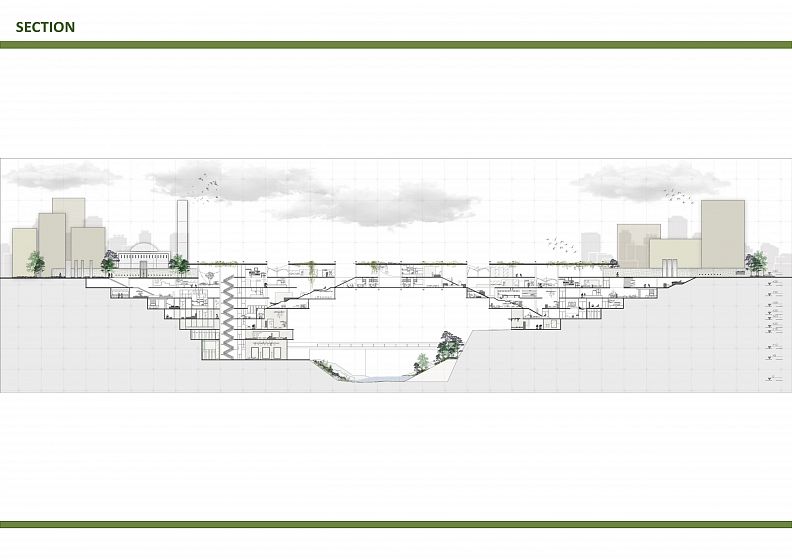THE RHIZOME

Project idea
The rhizome is by definition an underground and sometimes underwater stem filled with the
food reserve of certain perennial plants. But today, the concept of rhizome is sometimes used to
characterize architectures, or as a marketing starting point to develop a project. Basically with
botanical connotations, it was developed in the 70s and 80s by the philosophers Gilles Deleuze
and Félix Guattari. Literally, there are architectures in motion. Dynamic Architectures evolve
according to the wishes of users. It is a concrete application of architecture in motion. When we
talk about the rhizome, beyond the connections, we also talk about becoming. There is no static.
Things are moving. From the tearing of a singular point to a multiplicity, becoming leads to the
vicinity of another point, from which it can resume its movement. Always going further in this
process.
After a series of extensive research on the nature-man relationship, my choice fell on the
rhizomes which are a perfect example of this relationship. The rhizomes are composed of five
elements: the roots, the horizontal development of things and not vertical, a non-hierarchal
structure, the presence of a fractal culture, and finally a multiple application as in philosophy,
art, or the study of social and political developments.
The principles of this theory are:
-Showing the connection between nature and town planning.
-Showing a heterogeneous model between human and natural structures.
-Defining the ruptures already present in this environment.
- Highlighting the multiplicity of the chosen site.
- Presenting a mapping of the project.
Tripoli is the capital of northern Lebanon; it is 85 km far from Beirut and has an area of 27 km2. It
is widely populated. Tripoli was the epicenter of several civilizations, indeed, it is built on the site
of an important Phoenician city which played a big role in the IVth century before Christ. Then, it
was taken by the Romans and Byzantine then the Arabs in the 7th century and experienced a
flourishing period. Then, it was the capital of the Frank count of Tripoli at the time of the
crusades, its port had a great commercial importance. It then underwent domination by the
Mamluks of Egypt and then by the Ottomans. Tripoli was chosen because it is the city of
opposites, a city divided between order and chaos, old and new, spaced and superposed. All this
is well explained by the points and spots represented on the following diagram and by the
division created by the river. The site was chosen for its strategic location. Right in the middle of
everything. Between rich and poor city, of different religions, divided by the Abou Ali river in the
middle. In addition, the site is located roughly in the commercial heart of Tripoli.
Project description
The project is inspired by Islamic architecture, a versatile and interchangeable architecture. The
project begins with a basic unit which, using the surrounding vacuum, changes and modifies
according to the needs of the community. The entry will be sufficient to show the overall aspect
of the project. An environmental game is also planned, where everything is transformed to
create an inseparable coherence between light, surroundings, needs…
The main structure of my project is the crusade citadel of Raymond de Saints Gilles. This citadel
dates from 1103 and is located at the lowest point of the Kadisha valley. This monument has had
different surroundings throughout its existence. In 1103, the Abou Ali river bordered it on all
sides then in 1965 and after a flood, concrete support walls were built so as not to ruin the
structure of the citadel. The route that will be taken to arrive at the citadel will start at the "souk
el khiyyatin" then passes near 4 other stages before ending at khan al saboun, the traditional
workshop for the creation of all kinds of natural soaps.
Technical information
This part of the city was teeming with life and greenery with impeccable architecture.
This city was one of the economic centers of Tripoli until 1965 when a flood engulfed this part
and led to the destruction of irreplaceable historic sites and monuments. The flood also led to
the construction of a 24m wide and 8m high replacement canal that ruined the natural bank of
the river and the region's innate rhizome
We must create a historic passage that goes around all the historic monuments that
will highlight the sites in general and the region mainly. Second, and taking into account the two
zones A and B which are heterogeneous in level: religion, society, and economy, we must create
a residential and productive space. Finally, it is necessary to create an artisanal space to give
place to the craft industry in two purely residential and economic plains. The nature of the
sloping region gives us an advantage. By connecting all the historic structures with the help of
the historic passage, you unknowingly create a podium highlighting the citadel, the region's
primary historical attraction
The rhizome theory explains well the underground evolution of the roots and
in the field of architecture it is at the base of the environment, the climate, and the society
which enters the agglomeration and the urban evolution. The transformation of the architecture
from horizontal development to vertical development is necessary today to protect our natural
heritage. And everything is already there. My project will therefore reside on the residential side
with fractal, stacked, chaotic architecture. It will be built in a new way that will merge with the
geometry of the environment..








































